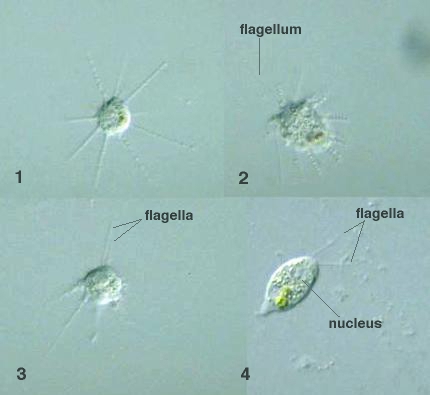
 Dimorpha mutans
Dimorpha mutans
Gruber, 1881
 Genus: Ovoid or subspherical; with two flagella and radiating axopodia, all arising from an
eccentric centriole; nucleus eccentric; pseudopods sometimes withdrawn; fresh water (Kudo, 1966).
Genus: Ovoid or subspherical; with two flagella and radiating axopodia, all arising from an
eccentric centriole; nucleus eccentric; pseudopods sometimes withdrawn; fresh water (Kudo, 1966).
Species:
Spherical cell body (heliozoan type) 15-22 μm in diam. (Page & Siemensma, 1991).
|
Similar genus -->> Ciliophrys;
Dimorpha mutans,
x 640, Mizumoto Park, Katsushika-ku, Tokyo, Japan, July 2001 by Y. Tsukii
 31 μm
31 μm
 63 μm
63 μm
 94 μm; x 640
94 μm; x 640
Heliozoa stage with flagella, cell body spherical, 9 μm in diam.




Cells undergoing morphological change from heliozoa to flagellate stage




Flagellate stage, cell body spindle-shaped, 22 μm long, 11 μm wide,






Dimorpha ?, morphological change from heliozoa to flagellate stage,
x 400, x 640, Mizumoto Park, Katsushika-ku, Tokyo, Japan, July 2001 by Y. Tsukii
 31 μm
31 μm
 63 μm
63 μm
 94 μm; x 640
94 μm; x 640
Heliozoa stage with flagella, cell body spherical, 14 μm in diam.


Heliozoa stage with flagella, cell body spherical, 9 μm in diam.




D. mutans Gruber: 15-20 μm diam.;
flagella about 20-30 μm long (Kudo, 1966).
D. floridanis Bovee: Flagellate phase 18-20 μm long,
6-7 μm wide;
two flagella 10-12 μm long, one directed
anteriorly and the other bent laterally; heliozoan form 8-10
μm diam.; fresh water (Kudo, 1966).
Please click on images for viewing enlarged.
Copyright
Protist Information Server
 Genus: Ovoid or subspherical; with two flagella and radiating axopodia, all arising from an
eccentric centriole; nucleus eccentric; pseudopods sometimes withdrawn; fresh water (Kudo, 1966).
Genus: Ovoid or subspherical; with two flagella and radiating axopodia, all arising from an
eccentric centriole; nucleus eccentric; pseudopods sometimes withdrawn; fresh water (Kudo, 1966).



















